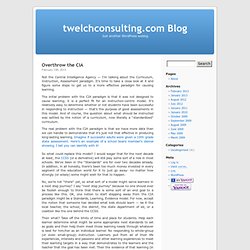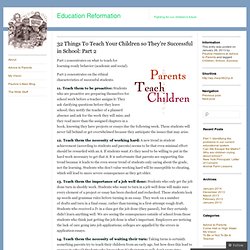

4C-ID. This article or chapter is incomplete and its contents need further attention.

Some information may be missing or may be wrong, spelling and grammar may have to be improved, use your judgment! 1 Definition 4C/ID is an instructional design model by van Merriënboer and others. "4C" means "four components", "ID" means "Instructional Design". It also can be found in Merrill's first principles of instruction. According to Martin Ryder, the The 4C-ID instructional model is characterized by four components: (1) Learning Tasks, (2) Supportive Information, (3) Procedural Information and (4) Part-Task Practice. See also: Elaboration theory (a much earlier model from Reigeluth). 2 The design. Science educator and homeschool mom passionate about family life, traveling, cultural heritage, & staying active.Eva Varga. A Blog about Open and Online Education. Teacher blogs.
Cool Cat Teacher Blog. MOOCs and Libraries. Blog. In a blog post by Ben Johnson published this morning in Edutopia there was a call for deeper learning (interesting term, isn’t it — I used to think I understood it, but not so sure anymore — I don’t know that learning should be so much about depth as it is connection, but that’s for another day).

Johnson’s article was entitled “Deeper Learning: Why Cross-Curricular Teaching is Essential”. If you have been following my blogs you know that my first reaction was to the word “teaching”. I find it to be a huge leap to go from cross-curricular teaching to deeper learning given the challenge of even a simple teaching=learning equation. Silly me, right? But let’s leave the requirements and look at the phases of teacher collaboration needed. Alignment — suggestion was that teachers “wade” in the same direction as their colleagues.
Cooperative — The example here is the math and science teacher who get together and decide the best way to teach motion. Ramblings of a Gifted Teacher. March 4, 2013 Jeffrey Shoemaker Gifted Gifted, rubrics Many of us have used rubrics to grade our students.

They use rubrics for some of thier writing on state exams. Some of our teachers here use rubrics for students to grade examples of work. So this year I am moving away from rubrics that I make or some premade rubrics to student generated rubrics. Getting students to make their own rubrics wasn’t an easy task. 1. 4. 5. Education Unbound Blog - Online Universities.com. Getideas.org. Education Week American Education News Site of Record. Educational Blogs and Magazines. Chicago Education, Politics, and Labor Union News - Substance News. Schools Matter. Web 20 Teach. Web 2.0 Teaching Tools. Education articles from my blog.
Udacity Blog. Miss Rim's tales from the short bus. Education Ultimate. Accountable Talk. Peer grading: inventing the light bulb. A real-time chronicle of a seasoned professor who has just completed giving his first massively open online course.

With the deadline for submitting the final exam in my MOOC having now passed, the students are engaging in the Peer Evaluation process. I know of just two cases where this has been tried in a genuine MOOC (where the M means what it says), one in Computer Science, the other in Humanities, and both encountered enormous difficulties, and as a result a lot of student frustration. My case was no different. Anticipating problems, I had given the class a much simplified version of the process – with no grade points at stake – at the end of Week 4, so they could familiarize themselves with the process and the platform mechanics before they had to do it for real.
That might have helped, but the real difficulties only emerged when 1,520 exam scripts started to make their way through the system. By then the instructional part of the course was over. 32 Things To Teach Your Children so They’re Successful in School: Part 1 « Education Reformation. As part of my Education Reformation, The Never-Give-Up Initiative, I have mentioned the equal balance of responsibility among students, teachers, and parents.

The greatest obstacle children face in their achievement of educational success is the misconception that teachers will teach them everything they need to know. Teachers must teach their content area, but they cannot just pour that information into students’ brains. Students have to be prepared to receive the knowledge, and they must have the desire to apply that information. That’s where parents’ roles are crucial. Instead of expecting that teachers can somehow miraculously get a child to listen, when he hasn’t listened to his parents for 5-10 years, parents can be proactive in creating the best scenario for all involved.
Let me start by saying I’m not the perfect parent, by any means. 32 Things To Teach Your Children so They’re Successful in School: Part 3 « Education Reformation. Part 1 concentrates on what to teach for learning-ready behavior (academic and social).

Part 2 concentrates on the ethical characteristics of successful students. 32 Things To Teach Your Children so They’re Successful in School: Part 2 « Education Reformation. Part 1 concentrates on what to teach for learning-ready behavior (academic and social).

Part 2 concentrates on the ethical characteristics of successful students. 11. Teach them to be proactive: Students who are proactive are preparing themselves for school work before a teacher assigns it: They ask clarifying questions before they leave school; they notify the teacher of a planned absence and ask for the work they will miss; and they read more than the assigned chapters in a book, knowing they have projects or essays due the following week. These students will never fall behind or get overwhelmed because they anticipate the issues that may arise. 12. 13. 14. 15. 16. 17. 18. 19.